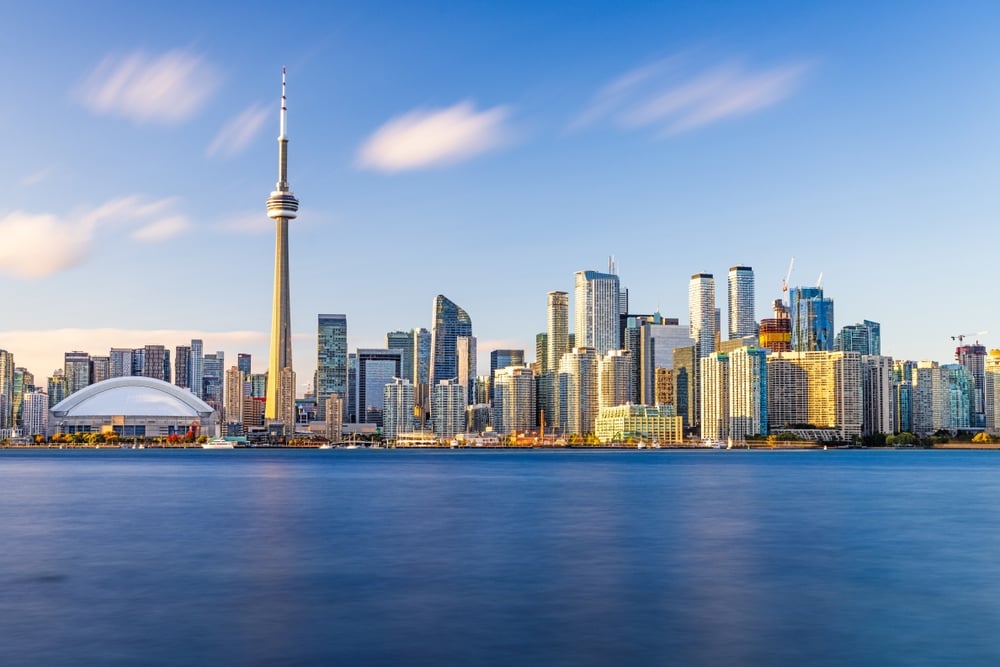Toronto is Canada’s dynamic global hub and largest city, offering so much to explore, from its towering skyline and world-class museums to its globally diverse culinary scene. While Montreal charms visitors with its distinctly European and historic atmosphere (as you will see in my 3-day Montreal itinerary), Toronto offers a compelling contrast as Canada’s modern, dynamic, and multicultural center. Over the next four days, you will dive into the best of the city, balancing iconic tourist sights with a relaxed exploration of its unique cultural hubs and green spaces.
Important Notes
- This itinerary includes four full days to explore Toronto.
- There are no time constraints in this itinerary, allowing you to explore the city at your own pace and keeping in mind potential traffic and the lengths of different tours you might choose.
Using the Toronto Metro (TTC)
Conveniently, downtown Toronto is highly walkable, and the city’s metro system makes navigating between its iconic neighborhoods straightforward! Toronto’s metro system (subway) is operated by the Toronto Transit Commission (TTC). There are three lines: Line 1 Yonge–University; Line 2 Bloor–Danforth; and Line 3–Sheppard, with three more under construction.
The TTC no longer offers a dedicated weekly or tourist pass. Therefore, the easiest way to pay to use the metro is to tap your credit/debit card or your phone/smartwatch (such as Apple Pay or Google Pay) on the fare gate reader as you enter the station. The cost is a flat $3.30 adult fare, which grants you a free 2-hour transfer window.
Day 1: Downtown and Iconic Landmarks
Today, you will be exploring Toronto’s Entertainment District, which is the vibrant, pulsating heart of downtown Toronto, a major hub for culture, arts, sports, dining, and nightlife. It’s an essential area for both tourists and locals looking for a dynamic city experience!
CN Tower
The first stop on your Toronto itinerary is the famous CN Tower! The CN Tower is a must-see in Toronto, offering incredible views and several unique activities. The CN Tower is the most distinctive feature of the Toronto skyline and a major national symbol of Canadian engineering and innovation. It stands at 553.3 meters (around 1,815 feet) tall and held the title of the world’s tallest freestanding structure on land for 32 years (from 1975 until 2007). Today, it remains the tallest freestanding structure in the Western Hemisphere.
I recommend visiting before 11am on a weekday to avoid crowds. A standard visit to the observation decks takes 1.5 to 2 hours, but you should budget extra time for potential queuing. All observation decks are open between 9:30am and 11pm. There are several different ticket options available (starting at $45 CAD) on the official CN Tower website. Make sure to buy tickets in advance online to save money and not have to wait in line on the day you visit.
CN Tower ticket options
Timed General Admission (The LookOut Level): This is the main observation deck at 346 meters/114 stories (around 1,136 ft) high. It has floor-to-ceiling windows, offering a panoramic view of the city, Lake Ontario, and on a clear day, as far as Niagara Falls and New York State.
The Top: This observation deck is 33 storeys higher than the LookOut Level and the highest observation platform in the Western Hemisphere. You may even be able to feel the Tower sway in the wind on this level. You can also add The Top admission to your Timed General Admission ticket once you’re on the Main Observation Level (pending availability) for $12 CAD.
Sea the Sky: This ticket allows you to visit both the CN Tower and Ripley’s Aquarium of Canada for one low price! This package includes General Admission access to the CN Tower and Ripley’s Aquarium of Canada. If you really want to see Ripley’s Aquarium after your CN Tower visit, consider this ticket option!
Edgewalk: This is the world’s highest hands-free external walk on a building. Participants are harnessed and walk on a 1.5-meter-wide ledge outside the main pod.
Note: The most popular time to visit is sunset, but this means tickets will be more expensive.
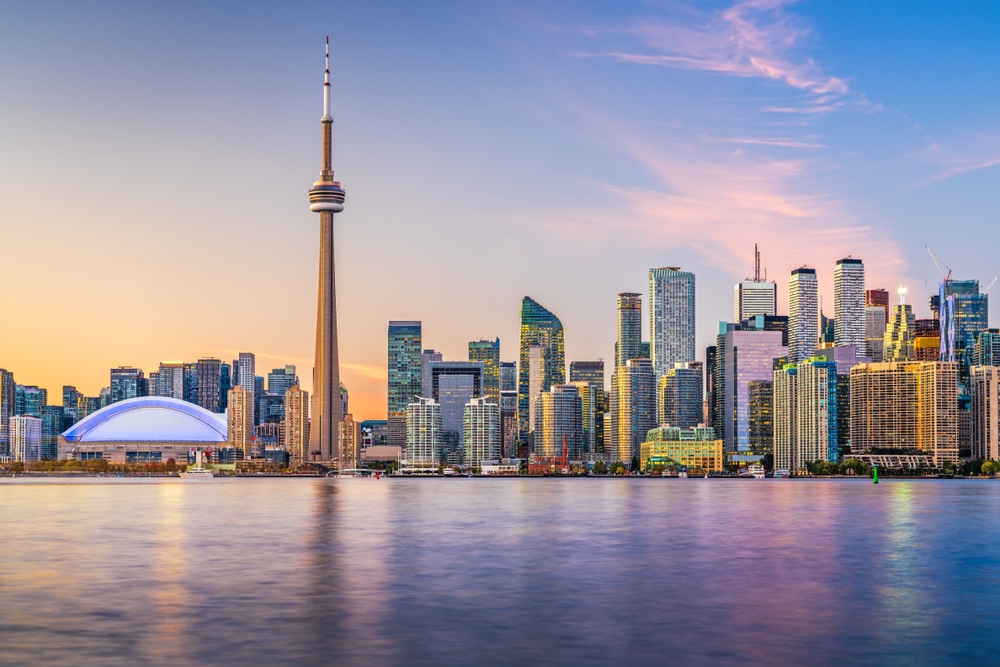
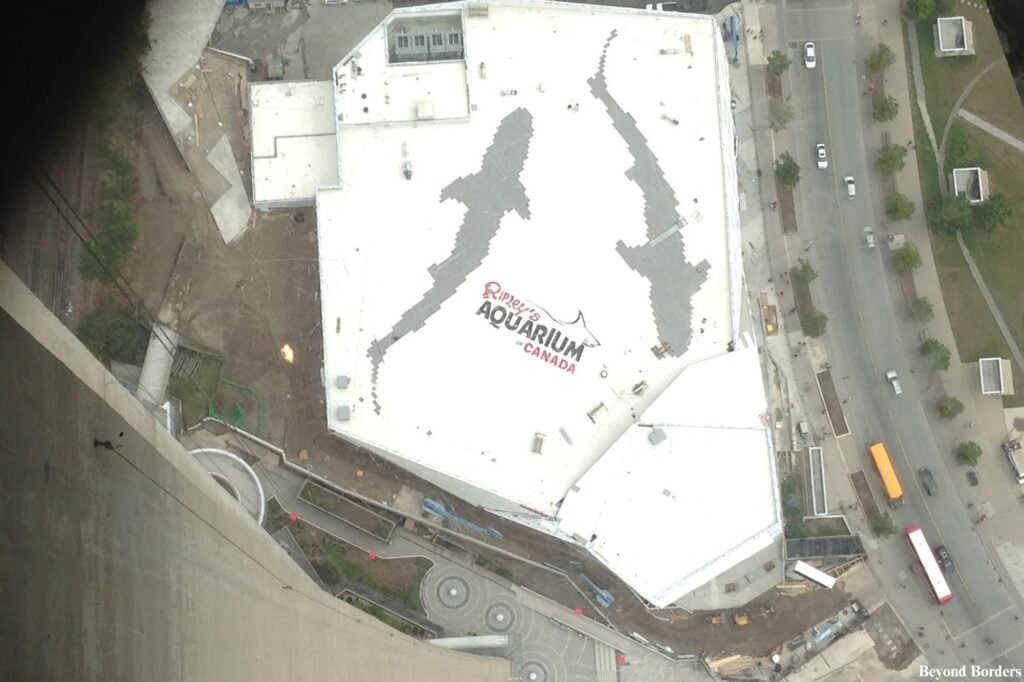
Lunch
For lunch, I suggest grabbing a casual bite near the CN Tower. Highly-rated places to eat include Kelly’s Landing, Scaddabush Italian Kitchen & Bar Front Street, and Loose Moose/Antler Room.
Afternoon
Ripley’s Aquarium of Canada or the Hockey Hall of Fame
Ripley’s Aquarium of Canada
Ripley’s Aquarium features over 20,000 aquatic animals in 5.7 million liters (1.5 million gallons) of water. It’s located right at the base of the CN Tower and is open daily from 9am to 9pm, but closed for special events. I recommend spending around 1.5 to 2.5 hours to fully explore the aquarium without rushing. Buy timed tickets online in advance to secure your entry slot and avoid waiting in line on the day of your visit. Purchase tickets on the official website.
The aquarium is divided into nine different galleries. Must-see galleries include the Dangerous Lagoon (the aquarium’s main attraction), a massive underwater tunnel with a moving walkway that carries you beneath sand tiger sharks, green sea turtles, giant sawfish, and large rays; Plant Jellies, a highly photogenic and mesmerizing exhibit featuring tanks of glowing jellyfish, all subtly lit with changing colors; Rainbow Reef, a colorful exhibit dedicated to the fish of the Indo-Pacific; Canadian Waters, which showcases the aquatic life found around Canada (look for the Giant Pacific Octopus and Wolf Eels!); and the Discovery Center, an interactive area that often includes touch pools where visitors can safely interact with creatures like stingrays and horseshoe crabs.
More Aquarium Features to Consider
Daily Shows: Be sure to check the daily schedule for Dive Shows (especially in the Dangerous Lagoon or Ray Bay) and various Aquarist talks or feedings!
Ray Bay Touch Pool: An exhibit where you can gently touch stingrays.
Hockey Hall of Fame
This is a museum and hall of fame dedicated to the history of ice hockey. It has the world’s largest collection of hockey memorabilia and is a must-visit for any hockey fan! The museum is usually open between 10am and 5pm daily (with extended hours during summer and holidays), and the average visit is 2 to 3 hours. Ticket prices vary by age group, and purchasing tickets on the official website in advance is recommended. Admission is generally valid for the whole day with a hand stamp, allowing you to leave and re-enter.
The Hockey Hall of Fame features many interactive exhibits, including the Esso Great Hall and NHL Trophies, home to the most comprehensive collection of silverware in sports, featuring all major current and many retired NHL trophies, including the Stanley Cup; Lord Stanley’s Vault, a bank vault that houses the original Stanley Cup and an extensive collection of Stanley Cup championship rings; an Interactive Zone; exhibits that showcase artifacts and memorabilia, and the World of Hockey Zone.
Harbourfront Centre: Arts, Culture, and Lakeside Views
Before (or after) your dinner in the Entertainment District, take a slight detour south to the Harbourfront Centre (just a short walk from both Ripley’s and the Hockey Hall of Fame). This 10-acre cultural hub is Toronto’s community campus for the arts, situated right on the shore of Lake Ontario. A major feature of the Centre is The Power Plant Contemporary Art Gallery, which offers compelling, free exhibitions.
Tip: Check the Harbourfront Centre’s calendar; they host hundreds of free festivals and events, especially on summer weekends, ranging from food markets to cultural celebrations. In the winter, the lakeside Natrel Rink is one of the city’s most scenic places to ice skate!
Evening
Dinner in the Entertainment District
After spending time in either Ripley’s Aquarium or the Hockey Hall of Fame, spend more time walking around the Entertainment District and get some dinner. You can find everything from casual pub fare to upscale, trendy dining, often with celebrity-chef tie-ins. I recommend walking around King Street West, which is especially famous for its concentration of popular restaurants and patios!
For a true Toronto experience, try the famous Thai dishes at Pai Northern Thai Kitchen (be sure to book a reservation in advance), or for a high-end evening, consider Patria for a Spanish tapas feast. Alternatively, for a dinner with an unforgettable view, check out the rooftop at Kost atop the Bisha Hotel. After your meal, you can easily transition to the late-night scene, as King West is lined with upscale bars and lounges—perfect for extending your evening.
Day 2: Old Town & Historic Districts
Toronto’s Old Town was the first of Toronto’s named neighbourhoods, having acquired the name no later than 1815.
St. Lawrence Market
Take the metro to King Station on Line 1 (yellow) and walk 10 minutes to St. Lawrence Market, one of Toronto’s most celebrated and historic landmarks, and often referred to as the city’s culinary center. This massive, multi-building public market has been a hub of community and commerce for over 200 years. Visitors can enjoy breakfast or lunch from numerous vendors and browse a wide variety of local goods. Its reputation is world-renowned—National Geographic even ranked it the best food market in the world. Feel free to eat breakfast and/or lunch here!
Note: The market is closed on Mondays.
The market is comprised of three different buildings:
St. Lawrence Market South (The Main Building)
This is the vibrant, multi-level public market that is open five days a week (Tuesday-Saturday, plus Sunday). It houses over 120 specialty vendors on the main and lower levels, selling an incredible array of goods: fresh produce, gourmet cheeses, baked goods, artisan breads, specialty oils, unique spices, coffee, and high-quality meats and seafood. The main building is famously known as the home of the Peameal Bacon on a Bun sandwich, a Canadian staple. Many vendors also offer prepared foods like fresh pasta, hot dishes, and world-class pastries. The second floor is home to the Market Gallery, a museum space operated by the city, dedicated to the city’s history and culture.
St. Lawrence Market North (The Farmers Market)
This building is traditionally the site of the Saturday Farmers Market, a tradition dating back to 1803. Farmers and producers from Southern Ontario bring their seasonal produce, meats, and dairy directly to the city. On Sundays, the North Market typically transforms into a popular Antique Market, with vendors selling various collectibles and vintage items.
St. Lawrence Hall
This hall is located across the street from the market buildings and contains commercial space on the ground floor and the beautiful Great Hall on the top floor, which is used for events and social functions.
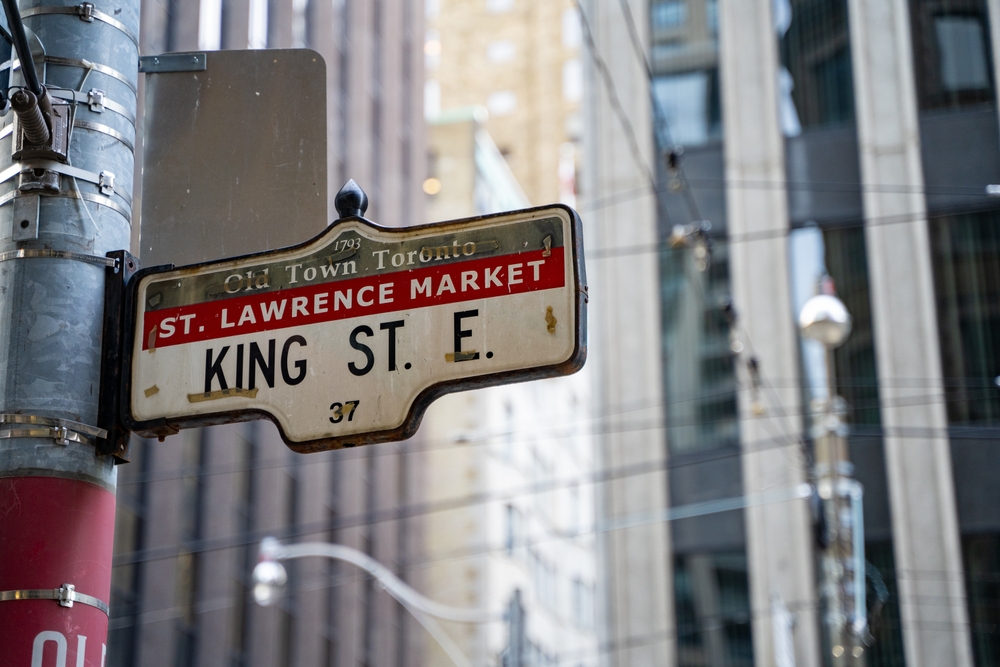
Nathan Phillips Square
After spending time in St. Lawrence Market, walk 20 minutes to Nathan Phillips Square, where you will see the famous TORONTO sign and the striking modernist Toronto City Hall. The Square features a large reflecting pool that transforms into a popular ice-skating rink in the winter, while the surrounding area is home to public art installations like the Peace Garden and the famous ‘The Archer’ sculpture by Henry Moore.
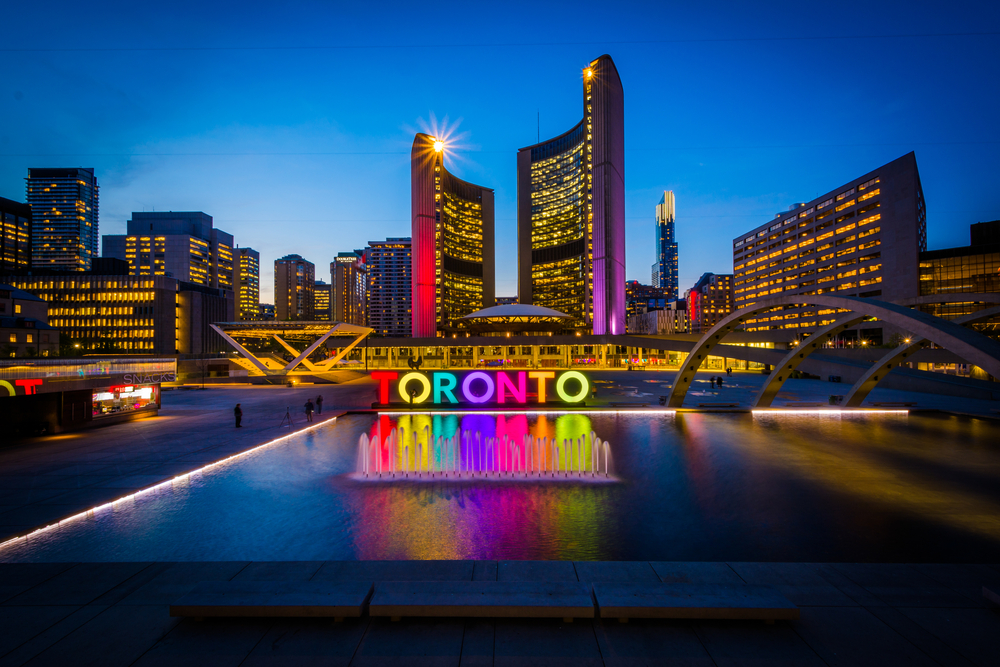
Distillery District
After taking photos at Nathan Phillips Square, you can either walk 35 minutes to the Distillery District or walk 10 minutes to King Station on Line 1 (yellow) and take the 504A King Streetcar (not the metro) eastbound and ride it to the final stop, the Distillery Loop. This loop is directly adjacent to the district.
The Distillery District is an internationally recognized National Historic Site, celebrated as the largest and best-preserved collection of Victorian Industrial architecture in North America. This charming, pedestrian-only village, defined by its cobblestone streets and striking brick buildings, was once the site of the massive Gooderham & Worts Distillery, which operated from 1832 to 1990 before being meticulously restored. Now, it serves as a dynamic hub for arts, culture, entertainment, and especially dining, offering a diverse array of unique boutiques, contemporary art galleries, theaters, and a curated mix of restaurants and cafes, including its own craft breweries and distilleries.
If you did not decide to eat lunch at St. Lawrence Market, consider eating in the Distillery District! You can find everything from French bistro fare and Spanish tapas to craft beer and custom-made chocolate, with popular eateries including Mill Street Brewpub, Spirit of York Distillery, which offers tours and tastings, and the gourmet SOMA Chocolatemaker, all contributing to its romantic, old-world European atmosphere, especially during major events like the annual Distillery Winter Village.
Dinner in Old Town or the Distillery District
Conclude your day with dinner, choosing between the charming, historic atmosphere of Old Town or by walking back to the Distillery District. In Old Town, you’ll find classic spots, particularly along Market Street and The Esplanade, perfect for upscale Canadian cuisine or a relaxed bistro meal. Some highly-rated restaurants in Old Town are Richmond Station’s Canadian cuisine, Gyu-Kaku Japanese BBQ for Japanese cuisine, and Cafe Oro di Napoli for authentic Italian cuisine.
Alternatively, the Distillery District offers a more European, romantic ambiance where the Victorian brick buildings are beautifully lit at night.”Dining in the Distillery District generally commands a higher price point than the excellent, often more approachable eateries found throughout Old Town. Highly-rated restaurants in the Distillery District include French cuisine at Cluny Bistro & Boulangerie, seafood at Pure Spirits, and Japanese at BOKU Japanese Eats + Drinks (Distillery District).
Day 3: Distinct Neighborhoods & Culture
Royal Ontario Museum (ROM)
Dive into history and culture at the immense Royal Ontario Museum, known as Canada’s premier museum for world cultures and natural history. Look for the striking Crystal entrance structure (the Michael Lee-Chin Crystal); you’ll find it directly above Museum Station on the metro. At the ROM, you will explore Canada’s largest collection spanning world cultures and natural history; be sure to see the impressive dinosaur skeletons in the Age of Dinosaurs gallery and the well-preserved artifacts in the Ancient Egypt collection! Plan to spend at least two to three hours here, as its 40 gallery spaces are packed with over 18 million artifacts and specimens.
Yorkville Neighborhood and Lunch
After immersing yourself in art and history at the ROM, you have an easy walk to get to the upscale Bloor-Yorkville neighborhood, widely known as Toronto’s capital of luxury, fashion, and culture. The main stretch of Bloor Street is often called “Mink Mile,” comparable to New York City’s Fifth Avenue, where you’ll find international luxury fashion houses like Chanel, Gucci, Hermès, and Louis Vuitton. Even if you’re only window shopping, the sophisticated displays and elegant architecture are an attraction in themselves.
When you’re ready for lunch, Yorkville offers nearly 200 dining options ranging from casual cafes to high-end spots. Popular and highly-rated restaurants include Trattoria Nervosa and Portici for Italian cuisine, or MSSM Yorkville for a modern Japanese meal.
Kensington Market
Take the metro from Bloor-Yonge station to St. Patrick station on Line 1 (yellow) and walk 10 minutes to Kensington Market. Kensington Market is a vibrant, eclectic neighborhood known for vintage shops, street art, and unique food vendors, officially designated a National Historic Site of Canada.
Kensington Market is a true microcosm of Toronto’s diversity. It’s a fantastic spot for a cheap food crawl, featuring global cuisine from all corners of the world. Additionally, it is arguably the best spot in the city for vintage and second-hand clothing! You’ll find countless independent boutiques, head shops, and quirky businesses selling unique items. Stores like Courage My Love and Exile are renowned for their retro finds, offering a diverse selection of items that range from handmade jewelry and crafts to rare international spices and specialty records.
Little Italy
After strolling through Kensington Market, walk 20 minutes west to Little Italy, centered along College Street West. Little Italy is one of Toronto’s most social neighborhoods, blending its historic European charm with a modern, multicultural energy. While historically the residential and commercial hub for Italian immigrants, the area today is a dynamic culinary destination, famous for its lively patio culture, a mix of authentic Italian eateries, and international restaurants and bars. The neighborhood boasts a vibrant nightlife scene, anchored by venues like The Royal Cinema and a host of popular cocktail bars. Walk around and consider getting some pastries at bakeries like National Bakery & Pastry, Bricolage Bakery, Bakery Pompette, or Barbershop Patisserie, all located on College Street.
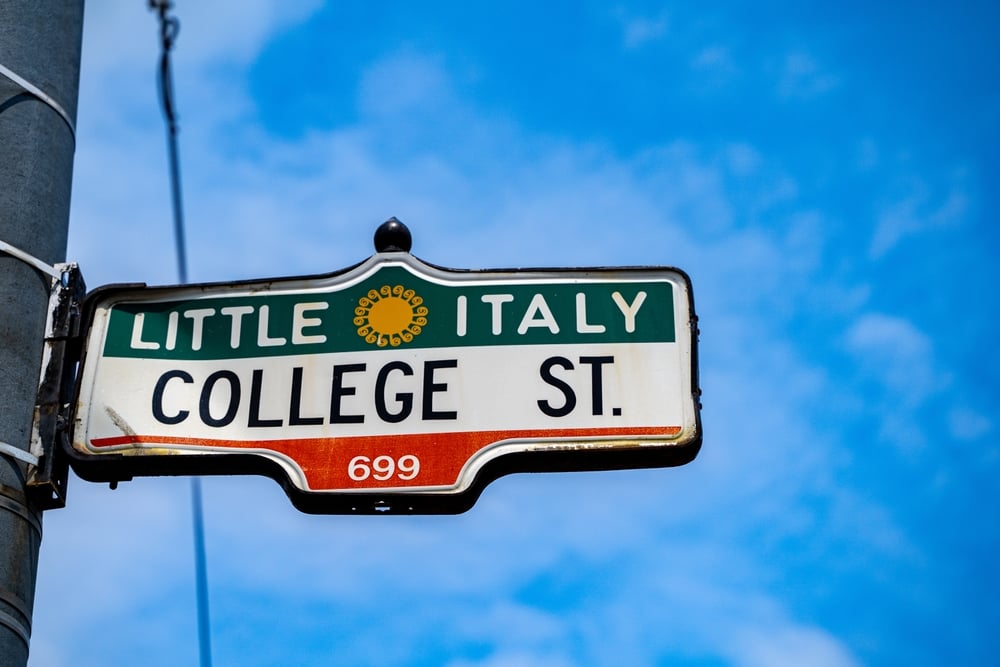
Dinner in Chinatown
Walk 20 minutes east to Chinatown for dinner. Toronto’s Chinatown perfectly captures the city’s multicultural energy and hosts a variety of Chinese, Vietnamese, Thai, Korean, and Japanese restaurants that range from dim sum and pho to modern fusion, all renowned for their quality, authenticity, and affordability. It is located at the intersection of Spadina Avenue and Dundas Street West. Popular restaurants in Chinatown include R&D and Cheng Du Street Food (Chinese), Juicy Dumpling, August 8 Chinatown (Japanese), Saigon Lotus (Vietnamese), and BIWON Korean Restaurant.
After dinner, walk through Dragon City Mall and/or Chinatown Centre, malls that have shops selling imported goods, clothing, unique Asian arts and crafts, traditional Chinese medicine, exotic spices, and gifts!
Day 4: Historic Castle & Waterfront Escape
Casa Loma
To get to Casa Loma, take the subway to Dupont Station (on Line 1–yellow). From there, you can either walk north up Spadina Avenue and then climb the Baldwin Steps (110 steps up the hill) or take the gentler paved path up the west side of the castle. Note: The castle is located on a steep hill–the walk from the subway is uphill.
Casa Loma (Spanish for “Hill House”) is a magnificent Gothic Revival-style mansion built between 1911 and 1914. It is often referred to as “North America’s only authentic castle” and sits atop a hill overlooking Toronto.
A general admission ticket (make sure to purchase them on the official website) includes a complimentary self-guided audio tour, granting you access to all of Casa Loma’s features. You can explore the Grand Interiors of the castle and climb the winding staircases to the top of The Towers for a spectacular panoramic view of the Toronto skyline—a perfect final-day photo opportunity!
Additionally, don’t miss the underground Basement and Tunnel exhibits, or the Stables and Carriage Room, where you can view a collection of vintage cars from the early 1900s, offering a glimpse into the Pellatt era of transportation. Finally, you can stroll through the meticulously maintained five-acre Estate Gardens (seasonal; best viewed from late spring to early fall) and visit the Queen’s Own Rifles Museum.
Plan for 1.5 to 2.5 hours to tour the castle thoroughly. As your first stop, aim to get there right when it opens to avoid the midday crowds. Casa Loma is generally open daily from 9:30am to 5:00pm; make sure to check their official website for holiday or event-related changes. I highly recommend arriving at 9:30!
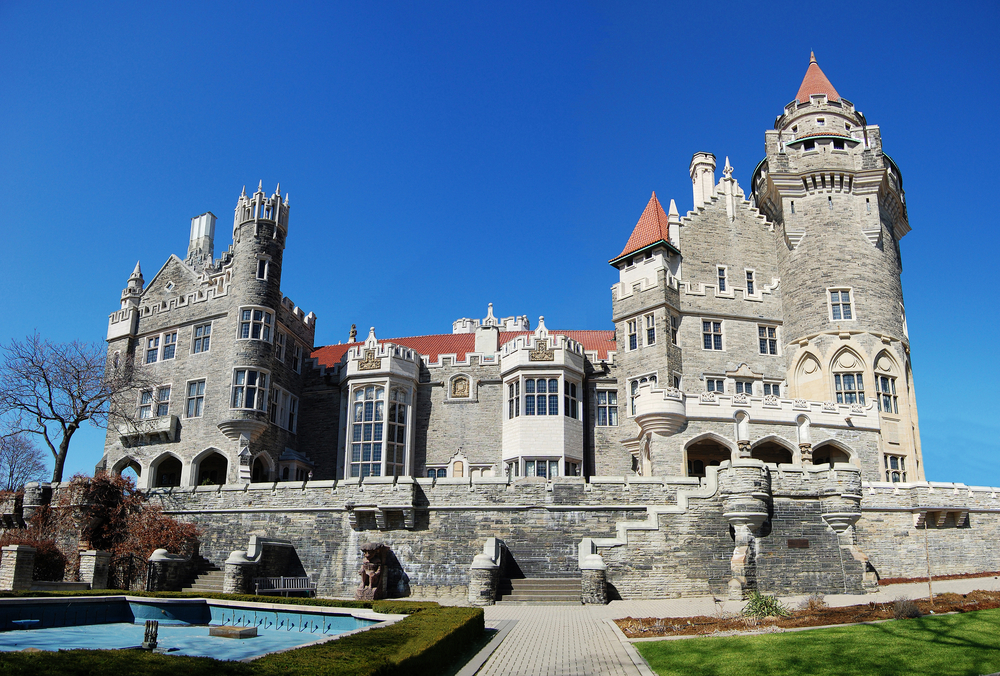
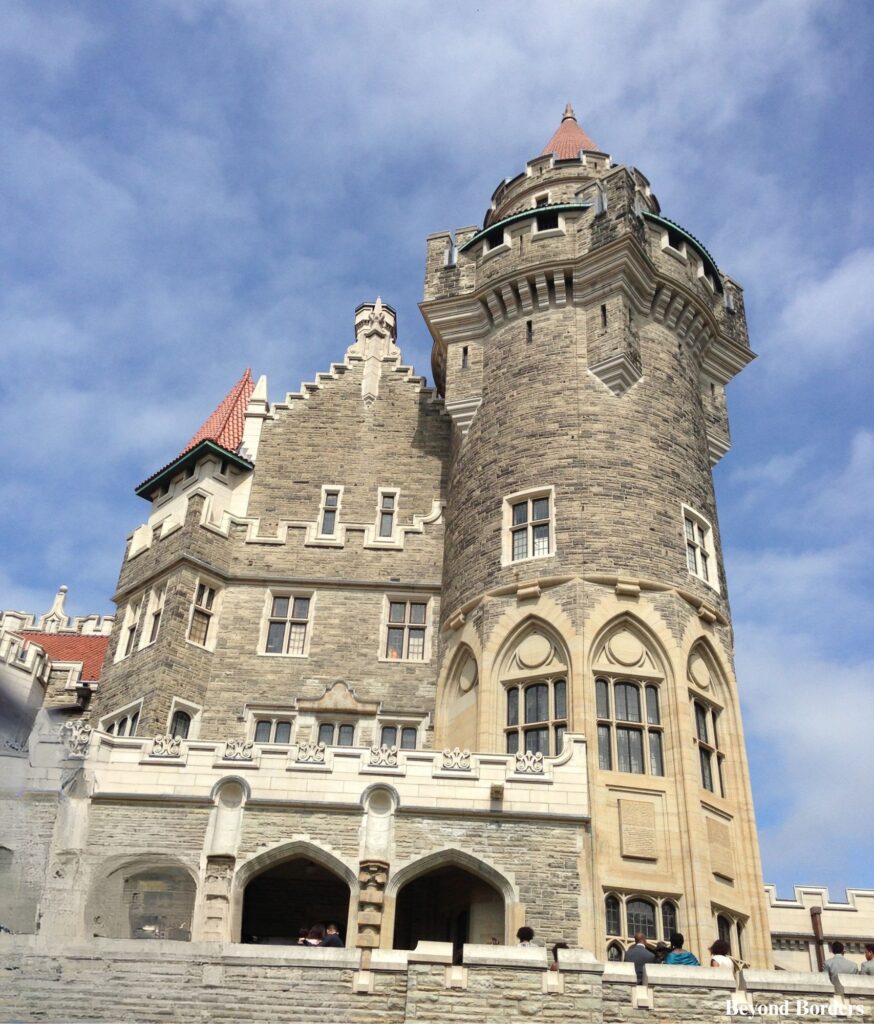
Lunch
After visiting Casa Loma, walk back to Dupont Station and take the subway southbound one stop to Spadina Station. Here, transfer to the Bloor-Danforth Line (Line 2) and travel westbound to High Park Station. From the station, it is a pleasant 10-minute walk to the heart of Bloor West Village for lunch. Known for its small-town charm within the city, this highly walkable, eight-block stretch of Bloor Street West is home to over 400 independent shops, specialty food stores, and diverse restaurants.
Some highly-rated and affordable places to eat here include WINGSTOP BLOOR and Sarang Kitchen (both chicken restaurants), Osmow’s Shawarma, Queen’s Pasta Café, and Brasa Peruvian Kitchen.
High Park
High Park, Toronto’s largest public park, is immediately adjacent to Bloor West Village! A late afternoon visit allows you to enjoy the trails, the tranquil Grenadier Pond (ideal for a waterfront stroll), the free High Park Zoo, and the formal Hillside Gardens. I recommend spending at least 2 hours here to relax. For families, be sure to visit the unique Jamie Bell Adventure Playground. If you are visiting in late April or early May, plan to see the park’s famous cherry blossoms (Sakura) around Hillside Gardens, which draw thousands of visitors each spring.
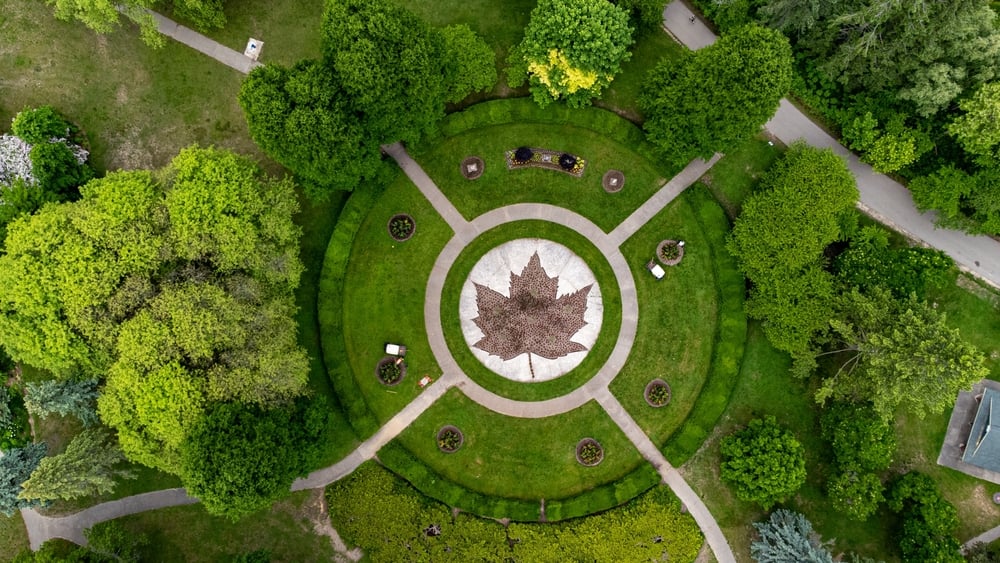
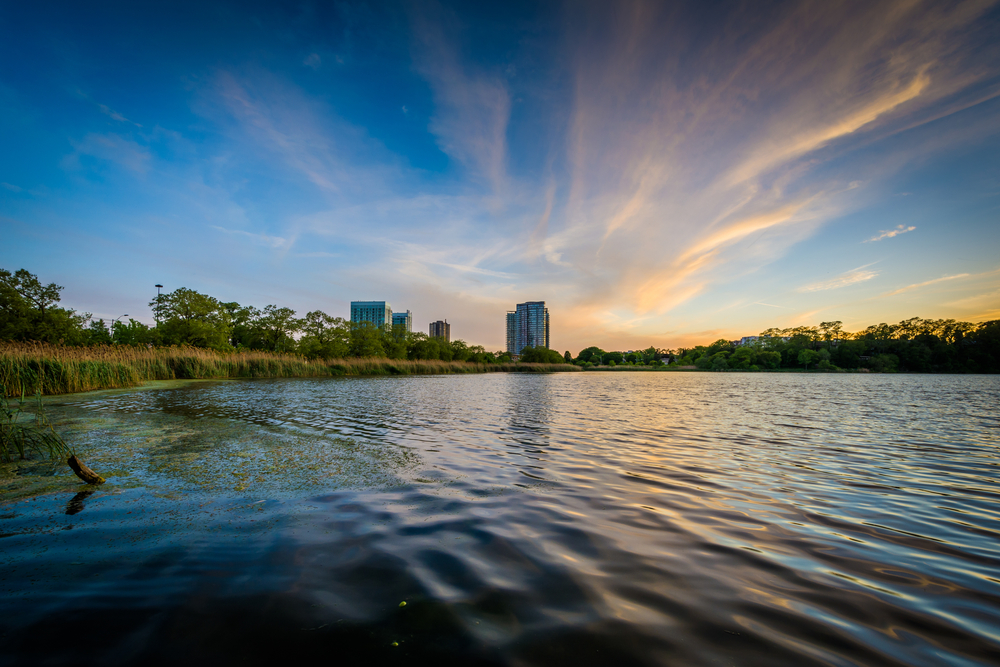
Waterfront and Ferry Ride
To reach the waterfront, take the Bloor-Danforth Line (Line 2) eastbound from High Park Station to St. George Station. Transfer there to the Yonge-University Line (Line 1), riding southbound to the final stop, Union Station. From Union Station, it’s a straightforward 10-minute walk south to the Jack Layton Ferry Terminal, which is your departure point for a short, scenic ferry ride to the Toronto Islands.
The islands offer the most iconic view of the Toronto skyline, along with peaceful parks, beaches, and walking trails. Tickets are to be purchased through the City of Toronto only on their official website. Tickets cost $9.11 (CAD) per adult (ages 20-64), $5.86 for children (ages 15-19 with ID) and adults ages 65 and up, and $4.29 for children (ages 2-14). Children 2 and under ride for free.
The 13 to 15-minute ferry ride is an attraction itself, offering a spectacular, unobstructed view of the Toronto skyline—perfect for photos! The ferry serves three main islands (Centre, Ward’s, and Hanlan’s Point). I recommend landing at Centre Island, as it provides easy access to Centreville Amusement Park and the famous, free Far Enough Farm. The islands are also a car-free zone, connected by a network of paths perfect for walking, biking, or relaxing on one of the four Blue Flag-certified beaches.
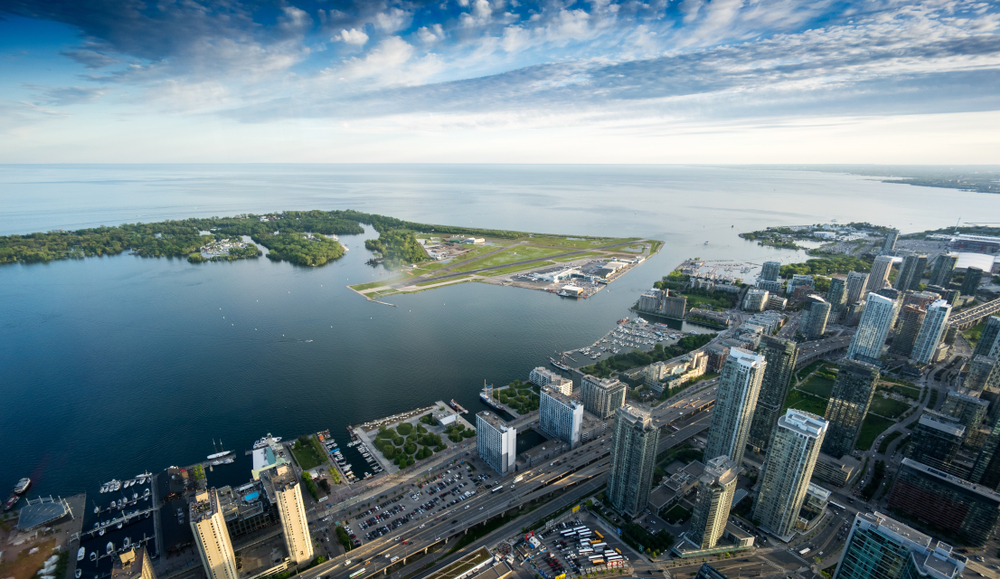
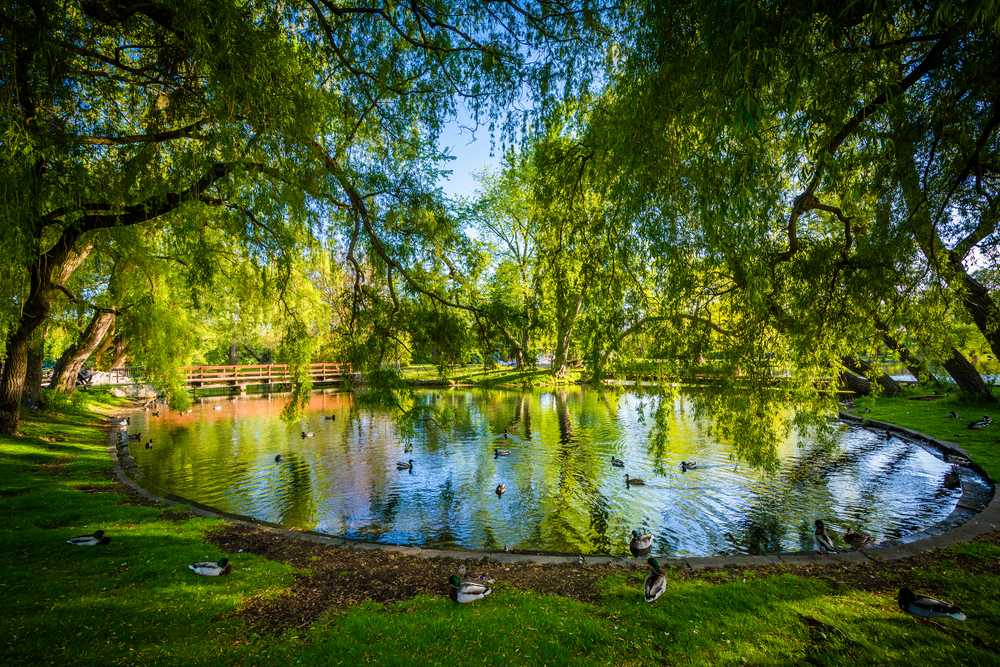
Dinner on the Toronto Islands
Consider timing your visit to enjoy dinner at one of the few licensed island restaurants, such as Toronto Island BBQ & Beer Co. for great skyline views, or the quieter Rectory Café on Ward’s Island. Dining on the island allows you to catch the illuminated city skyline on the final ferry ride back, which is one of the most memorable photo opportunities in Toronto! Be sure to check the seasonal ferry schedule for the last departure back to the Jack Layton Terminal. During the peak summer season (roughly May to September), the ferries run regularly, and the last ferry back to the city can be as late as 11:30pm from Centre Island or 11:45pm from Ward’s Island.
Alternative Attractions
If you have extra time, want to try something else, or if any attractions are too crowded for your liking or are unexpectedly closed, here are some other things to do:
Art Gallery of Ontario (AGO)
The AGO is one of the largest and most distinguished art museums in North America, located in downtown Toronto, renowned both for its extensive collections and its striking architecture. The building itself is a masterpiece, notably featuring the visionary design by Frank Gehry, with a curving, glass-and-wood facade along Dundas Street and a massive Douglas fir-clad spiral staircase that rises dramatically through the central Walker Court.
This architectural marvel houses a vast collection totaling over 120,000 works, spanning Canadian and Indigenous art (including the Group of Seven), European masterpieces (from Italian Renaissance to Impressionism and Post-Impressionism like Claude Monet and Pablo Picasso), Modern and Contemporary art, and the world’s largest public collection of sculptures by Henry Moore.
Tickets cost $30 CAD for those 18 and up and are $15 for children ages 10-17, but are free for Ontarians 25 and under and for Indigenous Peoples. Purchase tickets on their official website.
Allan Gardens
Allan Gardens is one of Toronto’s oldest and most beloved public parks, famous for its historic conservatory that serves as a lush, tropical oasis in the heart of the city. The centerpiece of the park is the Allan Gardens Conservatory, a series of six interconnected greenhouses covering over 16,000 square feet. Its most iconic structure is the beautiful, glass-and-iron Palm House, built in 1910 in a neo-Classical and Edwardian style. The greenhouses are home to a diverse and permanent collection of plants from around the world, including:
- The Tropical House: Filled with equatorial plants, hibiscus, and tropical vines.
- The Arid House: Showcasing a striking collection of cacti and succulents.
- The Cool Temperate House: Featuring plants from cooler climates like Australia and the Mediterranean, including fragrant jasmine and camellias.
Admission to the Allan Gardens Conservatory is free and it is open year-round, making it a popular place to visit during Toronto’s cold winters. Beyond the conservatory, the park includes a large outdoor green space, an off-leash dog area, and a children’s playground. To read more about the gardens and conservatory, check out the official website.
Toronto Music Garden
The Toronto Music Garden is located along the city’s scenic waterfront at Queen’s Quay West and was designed by internationally renowned cellist Yo-Yo Ma and landscape designer Julie Moir Messervy. The garden is divided into six distinct sections, or “movements,” each reflecting a dance form:
- Prelude: Represented by an undulating riverscape with curves and Hackberry trees, suggesting a flowing melody and musical measures.
- Allemande: A contemplative birch grove with wandering trails.
- Courante: An exuberant, upward-spiralling path through a wildflower meadow that leads to a Maypole.
- Sarabande: An introspective arc-shaped grove of conifers, often called the “poet’s corner.”
- Menuett: A formal, symmetrical area with an ornamental steel pavilion designed for musical performances.
- Gigue: The final section, interpreted as giant grass steps that form a curved amphitheater, offering views of the harbour and serving as an informal performance space under a weeping willow tree.
The garden also hosts the annual “Summer Music in the Garden” series, which features free outdoor concerts, allowing visitors to experience the music that inspired the garden while surrounded by its physical interpretation.
Sankofa Square
Sankofa Square is one of Toronto’s most prominent public squares and outdoor venues, located in the heart of the downtown core at the intersection of Yonge Street and Dundas Street East. It was called Yonge-Dundas Square until December 2023, when it was renamed to Sankofa Square. It is often compared to New York’s Times Square due to its bustling atmosphere and the large, brightly lit digital billboards that surround it; the intersection is considered one of the busiest in Canada. The square also serves as a major hub for public events, concerts, cultural festivals, and art displays, including free programming and community-based activities.
What about Toronto CityPASS?
The Toronto CityPASS offers one-time admission to five attractions in Toronto: the CN Tower and Ripley’s Aquarium of Canada, and three of the following attractions: Royal Ontario Museum, City Cruises Toronto (closed between December and March), Casa Loma, and the Toronto Zoo. This pass bundles admission to five of the city’s must-see destinations, offering a significant discount compared to purchasing tickets separately.
Note: City Cruises Toronto does not operate the main ferry service to the Toronto Islands. The standard, public ferry service to the Toronto Islands (Centre Island, Ward’s Island, and Hanlan’s Point) is run by the City of Toronto from the Jack Layton Ferry Terminal. City Cruises Toronto offers a 1-hour sightseeing harbor tour that goes past the Toronto Islands; this is the tour included with the Toronto CityPASS.
Tickets are valid for 9 days starting on and including the first day you visit an attraction or have a reservation, and you have one year from the date of purchase to start using your tickets. Sale prices for tickets cost $97.44 (USD) for adults (ages 13+), and $69.67 for children (ages 4-12). Regular prices cost $157 (USD) for adults and $106 for children.
Since this 4-day itinerary includes most of these landmark locations, I highly recommend purchasing CityPASS for this itinerary! CityPASS provides both financial savings and the convenience of skipping ticket lines, streamlining your exploration of the attractions in this itinerary. Plan to purchase and activate your pass early on Day 1 to get the full benefit.
Where Should You Stay?
Luxury: Four Seasons Hotel Toronto; Fairmont Royal York
The Four Seasons is located within walking distance of both the Bloor-Yonge and Bay metro stations. Guests loved the attentive staff, the hotel’s proximity to shopping and restaurants, and spacious rooms. The Fairmont Royal York is a historic luxury hotel in downtown Toronto, close to Union Station and Scotiabank Arena. Guests appreciated the friendly staff, location, and lounges.
Mid-Range: The Annex Hotel; Old Mill Toronto Hotel
The Annex Hotel is a 5-minute walk from the Bathurst metro station. Guests describe the hotel as “unique” and love the clean rooms, location, and proximity to restaurants and bars. The Old Mill Toronto Hotel is a 5-minute walk from the Old Mill metro station, and guests appreciated the location, service, and clean rooms.
Budget: Holiday Inn Express & Suites Toronto Airport South by IHG; Homewood Suites by Hilton Toronto Airport Corporate Centre
These two hotels, though near Toronto’s International Airport, maintain excellent guest reviews. At both of these hotels, guests liked the clean rooms, good breakfast, and friendly staff.

